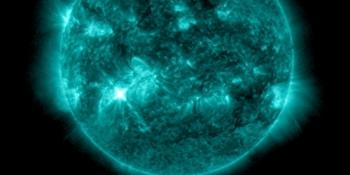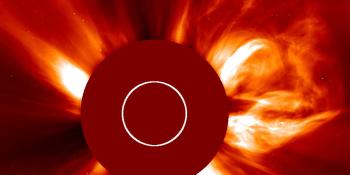Przeglądasz Archiwum z wtorek, 17 czerwca 2003
Raport aktywności słonecznej
Każdy wspomniany rozbłysk słoneczny w tym raporcie ma współczynnik skalowania dodany przez Space Weather Prediction Center (SWPC). Przez skale współczynników SWPC, raporty o rozbłyskach słonecznych są o 42% mniejsze niż naukowo jakościowa data. Skale współczynników zostały usunięte z naszych archiwów o rozbłyskach słonecznych by odzwierciedlić prawdziwe jednostki fizyczne.
Raport aktywności słoneczno- geomagnetycznej 2003 Jun 17 2200 UTCPrzygotowane przez NOAA © SWPC i przetworzone przez SpaceWeatherLive.com
Połączenie raportów USAF/NOAA o słonecznej i geofizycznej aktywności
Numer SDF 168 wydany w 2200Z na 17 Jun 2003IA. Analiza aktywności regionów słonecznych i aktywność od 16-2100Z do 17-2100Z Solar activity was at low levels. The largest flare
was a C2 flare at 0222 UTC from Region 386 (S07E58). This region
continues to increase in area coverage as it rotates further onto
the visible disk. Magnetic analysis indicates a beta-gamma
magnetic configuration. Region 380 (S15W64) continues a its gradual
decay in area and now has a beta magnetic configuration.
IB. Prognoza aktywności słonecznej
Solar activity is expected to be at
low to moderate levels with a chance of isolated high level
activity. Region 386 has the potential for major flare activity.
IIA. Podsumowanie aktywności geofizycznej 16-2100Z do 17-2100Z
The geomagnetic field was at active to major storm levels. A
six-hour period of southward Bz, from 06 - 09 UTC combined with
elevated solar wind speed near 510 km/s produced minor and major
storm levels.
IIB. Prognoza aktywności geofizycznej
The geomagnetic field is
expected to be at unsettled to minor storm levels. A weak CME shock
is possible late on day one with isolated minor storm levels
possible. High speed stream effects are expected on day two and day
three with minor storm levels possible.
III. Prawdopodobieństwa zdarzenia 18 Jun do 20 Jun
| Klasa M | 40% | 40% | 40% |
| Klasa X | 20% | 20% | 20% |
| Proton | 30% | 20% | 20% |
| PCAF | green | ||
IV. Przepływ 10,7 cm z Penticton
Zaobserwowano 17 Jun 122 Przewidywane 18 Jun-20 Jun 125/120/120 Średnia z 90 dni 17 Jun 125
V. Indeks geomagnetyczny A
Zaobserwowano Afr/Ap 16 Jun 020/032 Szacowane Afr/Ap 17 Jun 040/050 Przewidywane Afr/Ap 18 Jun-20 Jun 020/030-020/030-020/025
VI. Prawdopodobieństwa aktywności geomagnetycznej 18 Jun do 20 Jun
| A. Średnie szerokości geograficzne | |||
|---|---|---|---|
| Aktywne | 35% | 40% | 40% |
| Słaba burza | 15% | 20% | 20% |
| Bardzo znacząca burza | 05% | 05% | 05% |
| B. Wysokie szerokości geograficzne | |||
|---|---|---|---|
| Aktywne | 40% | 50% | 50% |
| Słaba burza | 20% | 25% | 25% |
| Bardzo znacząca burza | 10% | 15% | 15% |
Wszystkie czasy w UTC
<< Idź do codziennego przeglądu
Najnowsze wiadomości
Najnowsze wiadomości z forum
2024/12/23 AR13932 M8.9 & M4.1 associated CMEs 33AR 13932 85Season greetings from SpaceWeatherLive 5Ask your obscure/"stupid" space weather questions. 129A little bit about our hobby for the general public 10
Więcej tematówWesprzyj SpaceWeatherLive.com!
Wielu ludzi odwiedza SpaceWeatherLive aby śledzić aktywność słoneczną lub sprawdzić czy jest szansa na zaobserwowanie zorzy polarnej. Niestety, większy ruch na stronie oznacza większe koszty utrzymania serwera. Dlatego, jeśli jesteś zadowolony ze strony SpaceWeatherLive, zachęcamy do wspierania nas finansowo. Dzięki temu będziemy mogli utrzymać naszą stronę.

Fakty na temat pogody kosmicznej
| Ostatnie rozbłyski klasy X | 2024/12/08 | X2.2 |
| Ostatnie rozbłyski klasy M | 2024/12/25 | M4.9 |
| Ostatnia burza geomagnetyczna | 2024/12/17 | Kp5+ (G1) |
| Dni bez plam słonecznych | |
|---|---|
| Ostatni dzień bez skazy | 2022/06/08 |
| Średnia miesięczna liczba plam słonecznych | |
|---|---|
| listopada 2024 | 152.5 -13.9 |
| grudnia 2024 | 115.2 -37.3 |
| Ostatnie 30 dni | 120.1 -38.2 |


